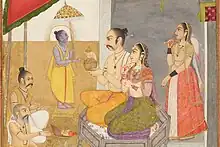| Vindhyavali | |
|---|---|
 Painting of Mahabali and Vindhyavali serving Vishnu in his dwarf form Vamana, while a suspicious Shukra tries to stop him. | |
| Personal information | |
| Parents |
|
| Siblings | Parvati, Ganga |
| Spouse | Mahabali |
| Children | Banasura, Namasu (Hinduism), Ratnamala |
Vindhyavali (Sanskrit: विन्ध्यावलि, romanized: Vindhyāvalī),[1] also known as Balika or Charuthi is the wife of the asura king Mahabali in Hindu texts,[2] with whom she had a progeny of one hundred children, including his two sons Banasura and Namasu, as well as a daughter named Ratnamala.
Legend
| Part of a series on |
| Hindu mythology |
|---|
 |
| Sources |
| Cosmology |
| Deities |
| Personalities of the Epics |
| Hinduism Portal |
In Hindu tradition, Mahabali, the son of Virochana and the grandson of Prahlada, was an asura king. Vindhyavali, Mahabali's wife, is identified as the daughter of Himavan. It is noted in certain accounts that Vindhyavalli exemplified the qualities of a virtuous and supportive family woman towards Mahabali.
Vindhyavali is a somewhat less frequently mentioned figure in Hindu scriptures. Descriptions depict Vindhyavali as both beautiful and compassionate, exhibiting a caring disposition towards all living beings. Some narratives further maintain that the Mahabali-Vindhyavalli couple resulted in the birth of one hundred sons, including the renowned Banasura and Namasu. As an exemplary wife to Mahabali, Vindhyavali is said to have evenly distributed her affection amongst all her one hundred sons. According to the Puranas, Vindhyavalli demonstrated great respect towards Mahabali's grandfather, Prahlada. It is also believed that Vindhyavalli once saved Banasura from the wrath of Krishna.[3]
See also
References
- ↑ Dowson, John (2013-11-05). A Classical Dictionary of Hindu Mythology and Religion, Geography, History and Literature. Routledge. p. 42. ISBN 978-1-136-39029-6.
- ↑ Walker, Benjamin (2019-04-09). Hindu World: An Encyclopedic Survey of Hinduism. In Two Volumes. Volume I A-L. Routledge. p. 452. ISBN 978-0-429-62465-0.
- ↑ Dalal, Roshen (2010). Hinduism: An Alphabetical Guide. Penguin Books India. ISBN 978-0-14-341421-6.